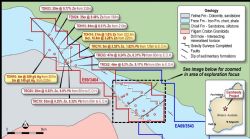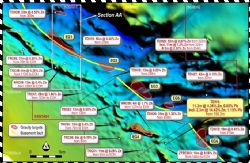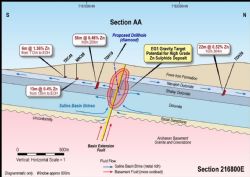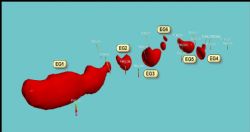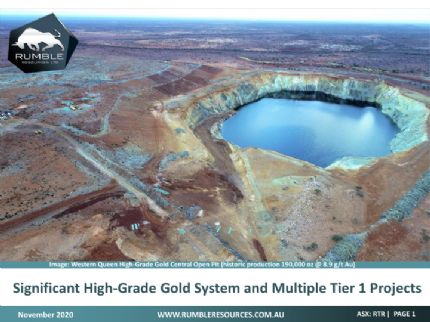 Drilling Commenced at Earaheedy Zinc Project
Drilling Commenced at Earaheedy Zinc Project
Perth, April 10, 2019 AEST (ABN Newswire) - Rumble Resources Ltd ( ASX:RTR) ("Rumble" or "the Company") is pleased to announce that it has commenced diamond core drilling at the Earaheedy Project. The drill programme will initially target up to four first order gravity targets recently identified (total six targets identified). The Earaheedy Project is located approximately 110km northeast of Wiluna, Western Australia.
ASX:RTR) ("Rumble" or "the Company") is pleased to announce that it has commenced diamond core drilling at the Earaheedy Project. The drill programme will initially target up to four first order gravity targets recently identified (total six targets identified). The Earaheedy Project is located approximately 110km northeast of Wiluna, Western Australia.
Highlights
Diamond Core Drill Programme - Commenced
- Drilling has commenced on two diamond core holes designed to test the large gravity drill targets EG1 and EG3, with contingency holes planned for gravity targets EG4 and EG6
- The large EG1 gravity drill target is up to 1.5km in strike length and up to 300m in width (similar width and length to the Pillara Zn-Pb Deposit located in the Lennard Shelf of Western Australia)
The gravity iso-shells are compelling drill targets that potentially represent large, mineralised zinc ore bodies, based on following:
- The gravity targets are located over the main interpreted basement extension fault and likely represent high to moderate angle fault breccia zones with high potential to host economic base metal mineralisation
- Importantly, modelling determined the dip of gravity targets are in line with the basement fault which could reflect mineralisation intrusion
- Large zinc metal accumulation identified within project from historic drilling with zinc mineralisation over an area of 20km by 3.5km (zinc horizon) - example intercept:
o 11.3m @ 4.34% Zn, 0.85% Pb from 150.2m
Includes 2.3m @ 14.42% Zn, 1.15% Pb from 150.2m
- Widespread Zn and Pb metal distribution surrounding the gravity targets
- Significantly all gravity targets are located within the flat lying carbonate unit that hosts the known zinc-lead horizon (from historic drilling)
- No historic drill-holes previously intercepted the first order gravity targets being drill tested by Rumble
Target Style
- Rumble is targeting Mississippi Valley Type (MVT) high-grade zinc deposits associated with basement faults (high angle breccia fault zones) within flat lying carbonate rocks
- Exploration has shown similarities to the historical Pillara (Blendevale) Zn-Pb deposit located in the Lennard Shelf of WA, with a strike of 2km, discovered between 80m to 500m below surface for a resource of 20Mt @ 8.3% Zn, 2.5% Pb, 17ppm Ag(see Note 1 below)
Project Overview
Rumble has an option agreement with Fossil Prospecting Pty Ltd (a wholly owned subsidiary of ASX Listed Zenith Minerals Ltd - ( ASX:ZNC)) to acquire a 75% interest in E69/3464. Rumble owns 100% of the contiguous application E69/3543.
ASX:ZNC)) to acquire a 75% interest in E69/3464. Rumble owns 100% of the contiguous application E69/3543.
Zinc and lead mineralisation with elevated silver is associated with the Navajoh Dolomite Member (also known as the Sweetwaters Well Member) of the Yelma Formation. The Yelma Formation is the lower unit of the 5000m thick Earaheedy Basin (Palaeoproterozoic). Sphalerite, galena, pyrite and marcasite (coarse grain) occurs as stratiform/stratabound ore fill veins and breccias, dissolution cavity fill, disseminated, stylolitic and fault fill mineralisation styles (Mississippi Valley Type). Broad spaced drilling (completed in the 1990's) defined oxidised and primary Zn-Pb mineralisation (zinc dominant) over a strike of 20km. The mineralisation is associated with a flat lying to shallow northeast dipping laterally continuous dolomite to shale horizon. The initial drill spacing was 5 to 10km. The current drill program spacing is approximately 2km by 1km.
Review of the historic drilling has concluded that approximately half the drill holes did not intercept the target horizon.
A total of 64 drill holes were previously completed within the project area (E69/3464), with 35 drill holes intercepting the stratiform zinc horizon (including partial end of hole intercepts). The historic drilling was completed by Renison (RGC) 1991 -1992 and Zenith in 2007 (8 RC holes completed). Rumble is confident that all holes are located accurately and the sampling and assay techniques represent best practice for the period.
Mineralisation has been defined over an area of approximately 20km by up to 3.5km in width and is completely open.
Six First Order Gravity Drill Targets (see Image 3, 4 and 5 in link below)
Two surveys covering an area of 24km2 were completed on 100m by 100m and 200m by 100m spacings (1080 stations). The surveys targeted the main basement fault zone (interpreted from aero-magnetics) and the stronger base metal drill-hole intercepts from the historic drilling. Gravity inversion modelling has defined six (6) first order drill targets that occur over the main basement fault structure (see Image 3 in link below). The targets are determined by variations in density contrasts (iso-shells). Targets EG1 to EG6 (see Image 3 & 5 in link below) are defined by the 0-200 (0.20 g/cm3) iso-shell.
Of Importance:
- The six gravity targets sit below the overlying Frere Iron Formation and their dip length strongly correlates with width of the carbonate formations that host the historic Zn mineralisation (see image 4 in link below).
- The steep dip of the gravity targets (steep southwest) also reflect the inferred dip of the underlying basement fault.
- The depth of the gravity targets gradually deepen to the southeast in line with the basement fault and dip of the hosting sediments.
- The gravity targets (EG1 to EG6) are interpreted to be associated with high angle fault/fault breccias that extend from the basement and are hosted in the main carbonate units.
- The targets represent bodies defined by density contrasts and these bodies may reflect denser carbonate rich zones or more significantly (based on the widespread Zn and Pb metal distribution), base metal mineralisation (epigenetic replacement).
- The gravity targets (iso-shells) are up to 1.5km in strike length (EG1) and up to 300m in width.
- Review of the historic drilling has indicated no drill hole has intercepted any of the gravity targets.
- Historic drill holes that are close to the gravity targets include TDH19 (approximately 250m into the hanging wall of target EG1 - see image 4 in link below) which returned a wide low-grade intercept of 56m @ 0.46% Zn from 209m.
Diamond Core Drilling Commenced (see Image 3, 4 and 5 in link below)
- Two diamond core holes will test gravity targets EG1 and EG3 with contingency holes for gravity targets EG4 and EG6.
- Image 4 (see link below) highlights the proposed diamond core drill hole into target EG1.
Target Potential and Style
The target style for the Earaheedy Zn project is considered Mississippi Valley Type (MVT) with economic sphalerite - galena mineralisation hosted in high to moderate angle fault/fault breccia.
Widespread flat lying carbonate replacement by low grade Zn and Pb sulphides has been delineated by historic drilling at Earaheedy. The area of flat lying mineralisation is very significant (20km by 3.5km) indicating extensive metal input and is completely open along strike and down dip. The historic drilling is wide spaced and has not tested the zone within the carbonates overlying the main basement fault.
Previous work by Rumble has highlighted strong metal zonation Zn:Pb ratios paralleling the basement fault (refer to ASX Announcement 12/10/2017 - Option Agreement to acquire Earaheedy Zinc Project). Metal zonation is characteristic of MVT deposits in the Devonian Lennard Shelf of Western Australia and has proven to be a useful vector to aid in delineating high-grade faults mineralisation.
The exploration completed to date at the Earaheedy Project has shown similarities to the historical Pillara (Blendevale) Zn-Pb deposit located in the Lennard Shelf of Western Australia (previously mined by BHP and Billiton from 1987 at Cadjebut, continued by Western Metals until 2003 and Teck/Xstrata between 2006 and 2008). The Pillara deposit occurred over a strike of 2 km and was located 80 to 500m below surface. The geological resource was 20Mt @ 8.3% Zn, 2.5% Pb, 17ppm Ag (based on 3% cutoff)(see Note below). The deposit produced 10.3Mt @ 6.9% Zn and 2.3% Pb. Of note, the discovery drill-hole (8m @ 8.9% Zn, 3.5% Pb below 210m)(see Note below).
Note: Reference: Murphy G C 1990 - Lennard Shelf Lead-Zinc deposits: in Hughes F E (Ed.), 1990 Geology of the Mineral Deposits of Australia & Papua New Guinea The AusIMM, Melbourne Mono 14, v2 pp 1103-1109
To view figures, please visit:
http://abnnewswire.net/lnk/L447Z7I1
About Rumble Resources Ltd
 Rumble Resources Limited (ASX:RTR) (FRA:20Z) is an Australian based exploration company, officially admitted to the ASX on the 1st July 2011. Rumble was established with the aim of adding significant value to its current gold and base metal assets and will continue to look at mineral acquisition opportunities both in Australia and abroad.
Rumble Resources Limited (ASX:RTR) (FRA:20Z) is an Australian based exploration company, officially admitted to the ASX on the 1st July 2011. Rumble was established with the aim of adding significant value to its current gold and base metal assets and will continue to look at mineral acquisition opportunities both in Australia and abroad.




![abnnewswire.com]()
Related Companies
Social Media
Share this Article

 ASX:RTR) ("Rumble" or "the Company") is pleased to announce that it has commenced diamond core drilling at the Earaheedy Project. The drill programme will initially target up to four first order gravity targets recently identified (total six targets identified). The Earaheedy Project is located approximately 110km northeast of Wiluna, Western Australia.
ASX:RTR) ("Rumble" or "the Company") is pleased to announce that it has commenced diamond core drilling at the Earaheedy Project. The drill programme will initially target up to four first order gravity targets recently identified (total six targets identified). The Earaheedy Project is located approximately 110km northeast of Wiluna, Western Australia.  ASX:ZNC)) to acquire a 75% interest in E69/3464. Rumble owns 100% of the contiguous application E69/3543.
ASX:ZNC)) to acquire a 75% interest in E69/3464. Rumble owns 100% of the contiguous application E69/3543.  Rumble Resources Limited (ASX:RTR) (FRA:20Z) is an Australian based exploration company, officially admitted to the ASX on the 1st July 2011. Rumble was established with the aim of adding significant value to its current gold and base metal assets and will continue to look at mineral acquisition opportunities both in Australia and abroad.
Rumble Resources Limited (ASX:RTR) (FRA:20Z) is an Australian based exploration company, officially admitted to the ASX on the 1st July 2011. Rumble was established with the aim of adding significant value to its current gold and base metal assets and will continue to look at mineral acquisition opportunities both in Australia and abroad.



